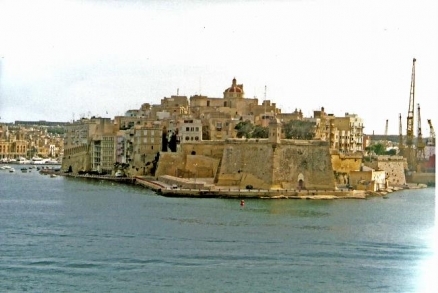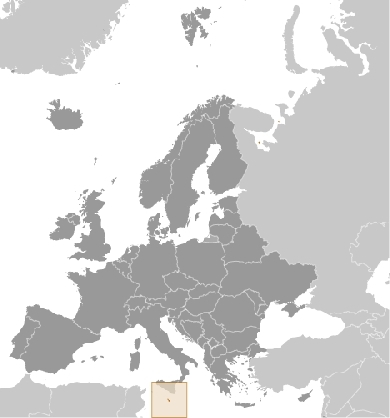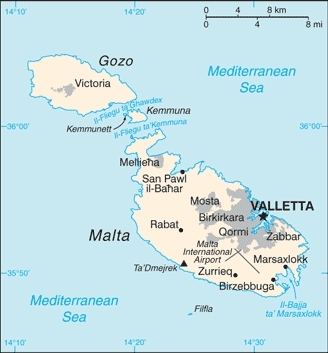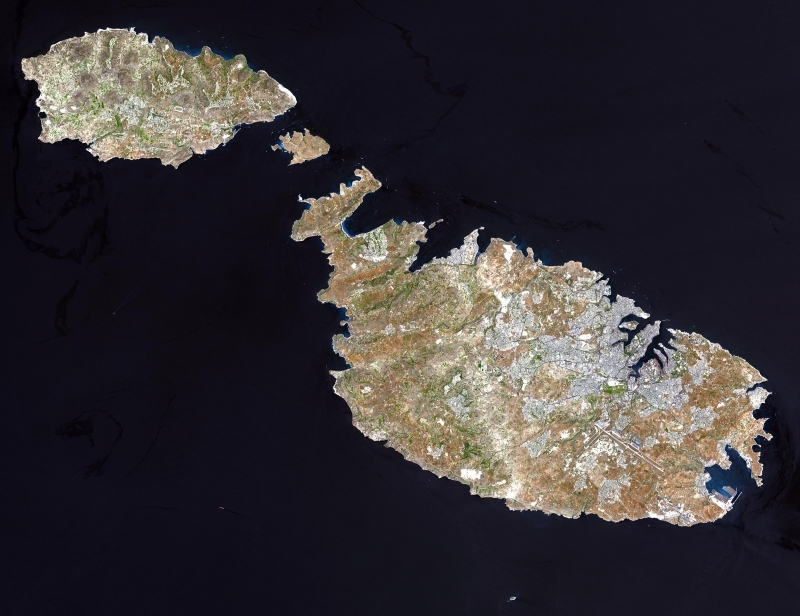Malta
Malta is a nation of islands with 410,000 people in the Mediterranean Sea, south of Sicily (Italy).
The country comprises an archipelago, with only the three largest islands (Malta, Ghawdex or Gozo, and Kemmuna or Comino) being inhabited; numerous bays provide good harbors.
Malta and Tunisia are discussing the commercial exploitation of the continental shelf between their countries, particularly for oil exploration.
Malta produces only about 20% of its food needs, has limited fresh water supplies, and has few domestic energy sources. Malta has few natural resources so the growth of tourism, especially since World War II, has gradually added to the Maltese economy.
Malta's geographic position between the EU and Africa makes it a target for illegal immigration, which has strained Malta's political and economic resources.
The capital and largest city, Valletta, is mainly built around a rocky peninsula, arrow-shaped peninsula extends northeast between two natural harbors (small, narrow, dark features). The geological faulting in this area has produced numerous fine natural harbors around the periphery of Malta.
Although the islands are composed of sedimentary rocks, mainly limestone and clays, the alkaline soils provide fertile conditions for the well-established agricultural economy. Precipitation amounts can be a problem in that the islands average only about 32 cm (12 in) per year.
Its major environmental issues include limited natural freshwater resources and an increasing reliance on desalination.
The many ancient monuments and remains on Malta attest to the great age of its civilization. Remains from Stone Age and Bronze Age peoples have been found in subterranean burial chambers. The islands became a Phoenician colony about
1000 B.C. They were later occupied by the Greeks, who called the colony Melita, and later the islands passed successively into the possession of Carthage and Rome.
The islands were occupied by Arabs in 870 A.D. A Norman army conquered the Maltese Arabs in 1090, and Malta was later made a feudal fief of the kingdom of Sicily.
In 1530 Holy Roman Emperor Charles V granted Malta to the Knights of Saint John of Jerusalem, who ruled the islands until the 19th century.
In 1798 Napoleon invaded and occupied the islands during his Egyptian campaign. Unwilling to be ruled by France, the Maltese appealed to Britain, and in 1799 British naval officer Horatio Nelson besieged Valletta and compelled the withdrawal of the French.
Great Britain formally acquired possession of Malta in 1814. The island staunchly supported the UK through both world wars and remained in the Commonwealth when it became independent in 1964. A decade later Malta became a republic.
Since about the mid-1980s, the island has transformed itself into a freight transshipment point, a financial center, and a tourist destination.
Malta became an European Union member in May 2004 and began using the euro as currency in 2008.
Malta is strategically located midway between the Strait of Gibraltar and the Suez Canal in the Mediterranean Sea.
Contents
Geography
Location: Southern Europe, islands in the Mediterranean Sea, south of Sicily (Italy)
Geographic Coordinates: 35 50 N, 14 35 E
Area: 316 sq km
Coastline: 196.8 km (excludes 56.01 km for the island of Gozo)
Maritime Claims:
territorial sea: 12 nm
contiguous zone: 24 nm
continental shelf: 200 m depth or to the depth of exploitation
exclusive fishing zone: 25 nm
Terrain: mostly low, rocky, flat to dissected plains; many coastal cliffs. The highest point is Ta'Dmejrek (253 m) (near Dingli).
Climate: Mediterranean; mild, rainy winters; hot, dry summers
Against the backdrop of black ocean water, Malta appears in shades of gray, beige, brown, and green. Gray cityscape stretches over much of the island, centered around the bustling port city of Valletta on the northeast coast, which hosts cruise ships, ferry boats, and yachts.
Away from the urbanized areas, the landscape alternates between cropland and natural vegetation. Malta’s winters are usually mild, but occasional wintertime frosts as well as high summer temperatures limit vegetation growth. Only a few patches of deep green appear in this shot, mostly on the western third of the island. The island’s terrain consists primarily of rocky, flat lowlands. Malta has no permanent rivers or lakes, but temporary waterways can form after heavy rains.
This natural-color image was acquired on July 29, 2001, by the Advanced Spaceborne Thermal Emission and Reflection Radiometer (ASTER) aboard NASA’s Terra satellite. Image courtesy NASA/GSFC/MITI/ERSDAC/JAROS, and U.S./Japan ASTER Science Team. Caption by Michon Scott.
Ecology and Biodiversity
Ecologically, Malta in within the Tyrrhenian-Adriatic sclerophyllous and mixed forests ecoregion which exhibits a forest, woodland, and scrub ecoregion along Italy’s southern coast and the surrounding islands of the Tyrrhenianand Adriatic Seas. The Malta islands host one of two European relict populations of the North African endemic coniferTetraclinis articulata.
People and Society
Population: 409,836 (July 2012 est.)
Malta is one of the most densely populated countries in the world, with about 3,423 inhabitants per square mile (1,322 per square kilometer). Inhabited since prehistoric times, Malta was first colonized by the Phoenicians. Subsequently, Romans, Arabs, Normans, the Knights Hospitallers of St. John of Jerusalem of Rhodes and of Malta, and the British have influenced Maltese life and culture to varying degrees. There are over 16,000 foreigners residing in Malta. The last decade saw an influx of Europe-bound migrants from sub-Saharan Africa, with some 4,000 in the country as of 2010. There was also a growing North African community of about 4,000 as of 2007. The constitution establishes Roman Catholicism as the religion of Malta; however, it also guarantees full liberty of conscience and freedom of worship and a number of faiths have places of worship on the island. Malta has two official languages--Maltese (a Semitic language with much vocabulary of Arabic origin and borrowed from Sicilian Italian) and English. The literacy rate has reached 93%, compared to 63% in 1946. Schooling is compulsory until age 16.
Ethnic Groups: Maltese (descendants of ancient Carthaginians and Phoenicians with strong elements of Italian and other Mediterranean stock)
Age Structure:
0-14 years: 15.7% (male 32,829/female 31,198)
15-64 years: 68.5% (male 142,006/female 137,803)
65 years and over: 15.8% (male 28,305/female 36,192) (2011 est.)
Population Growth Rate: 0.359% (2012 est.)
Birthrate: 10.31 births/1,000 population (2012 est.)
Death Rate: 8.72 deaths/1,000 population (July 2012 est.)
Net Migration Rate: 2 migrant(s)/1,000 population (2012 est.)
Life Expectancy at Birth: 79.85 years
male: 77.57 years
female: 82.26 years (2012 est.)
Total Fertility Rate: 1.53 children born/woman (2012 est.)
Languages: Maltese (official) 90.2%, English (official) 6%, multilingual 3%, other 0.8% (2005 census)
Literacy (age 10 and over can read and write): 92.8% (2005 Census)
Urbanization: 95% of total population (2010) growing at an annual rate of change of 0.5% (2010-15 est.)
History
Malta was an important cultic center for earth-mother worship in the 4th millennium B.C. Archeological work shows a developed religious center there, including the world's oldest free-standing architecture, predating that of Sumer and Egypt. Malta's written history began well before the Christian era. The Phoenicians, and later the Carthaginians, established ports and trading settlements on the island. During the second Punic War (218 B.C.), Malta became part of the Roman Empire. During Roman rule, in A.D. 60, Saint Paul was shipwrecked on Malta.
In 533 A.D. Malta became part of the Byzantine Empire and in 870 came under Arab control. Arab occupation and rule left a strong imprint on Maltese life, customs, and language. The Arabs were driven out in 1090 by a band of Norman adventurers under Count Roger of Normandy, who had established a kingdom in southern Italy and Sicily. Malta thus became an appendage of Sicily for 440 years. During this period, Malta was sold and resold to various feudal lords and barons and was dominated successively by the rulers of Swabia (now part of Germany), Aquitaine (now part of France), Aragon (now part of Spain), Castile (now part of Spain), and Spain.
In 1522, Suleiman II drove the Knights of St. John out of Rhodes, where they had established themselves after being driven out of Jerusalem. They dispersed to their commanderies in Europe, and in 1530 Charles V granted them sovereignty over the Maltese islands. For the next 275 years, these famous "Knights of Malta" made the island their domain. They built towns, palaces, churches, gardens, and fortifications and embellished the island with numerous works of art. In 1565, Suleiman the Magnificent laid siege to Malta. After several months, the Knights and the Maltese population prevailed and the Turks withdrew. Over the years, the power of the Knights declined, and their rule of Malta ended with their peaceful surrender to Napoleon in 1798.
The people of Malta rose against French rule, which lasted 2 years, and with the help of the British evicted them in 1800. In 1814, Malta voluntarily became part of the British Empire. Under the United Kingdom, the island became a military and naval fortress, the headquarters of the British Mediterranean fleet. During World War II, Malta survived relentless raids from German and Italian military forces (1940-43). In recognition, King George VI in 1942 awarded the George Cross "to the island fortress of Malta--its people and defenders." A crucial moment in Maltese history was August 15, 1942, when five out of the 14 vessels that formed part of "Operation Pedestal," including the American tanker SS Ohio, broke through the Nazi blockade of Malta to deliver fuel and food to the starving population. The arrival of the vessels was the turning point in the Maltese islands' fate during World War II, and became known locally as the Santa Marija Convoy, in honor of the August 15 Feast of the Assumption, referred to locally as "Santa Marija." President Franklin Roosevelt, describing the wartime period, called Malta "one tiny bright flame in the darkness--a beacon of hope for the clearer days which have come." In September 1943, the Italian fleet's surrender was signed in Malta by U.S. General Dwight Eisenhower and Italian Marshal Pietro Badoglio. Victory Day, celebrated on September 8, commemorates victory in the 1565 Great Siege, and the end of the World War II attacks in Malta.
Malta obtained independence on September 21, 1964, became a Republic on December 13, 1974. The last British forces left in March 1979. Malta joined the European Union (EU) on May 1, 2004.
With its central location in the Mediterranean, at one of the southernmost points of the European Union, Malta has long viewed itself as a bridge between Europe and North Africa, particularly Libya, with which it historically has enjoyed close diplomatic and commercial ties. During the period of rebellion in Libya that began in February 2011, Malta played an important role in supporting evacuation of third-country nationals, coordinating humanitarian aid to the people of Libya, and providing general assistance to forces of nations involved in enforcement of UN Security Council Resolutions 1970 and 1973.
Government
Government Type: Republic
Under its 1964 constitution, Malta became a parliamentary democracy within the Commonwealth. Queen Elizabeth II was Malta's sovereign, and a governor general exercised executive authority on her behalf, while the actual direction and control of the government and the nation's affairs were in the hands of the cabinet under the leadership of a Maltese prime minister.
On December 13, 1974, the constitution was revised, and Malta became a republic within the Commonwealth, with executive authority vested in a Maltese president. The president is appointed by parliament. In turn, he generally appoints as prime minister the leader of the party that wins a majority of seats in a general election for the unicameral House of Representatives.
The president also nominally appoints, upon recommendation of the prime minister, the individual ministers to head each of the government departments. The cabinet is selected from among the members of the House of Representatives, the number of which may vary between 65 and 69 members elected on the basis of proportional representation. The constitution provides for general elections to be held at least every 5 years. Candidates are elected by the Single Transferable Vote system, where the surplus votes of an elected candidate are transferred to the candidate receiving the second preference votes. The process of vote transfers continues until all five candidates for a district are elected.
Capital: Valletta - 199,000 (2009)
Administrative divisions: none (administered directly from Valletta); note - local councils carry out administrative orders and have some responsibility for local road and other public maintenance.
The Local Councils Act, 1993, which was drawn up on the European Charter of Local Self-Government, divided Malta into 67 (later 68) localities; 14 are in the smaller island of Gozo. Councilors are elected every 3 years by inhabitants who are registered as voters in the Electoral Register. Recent changes to the legislation will gradually increase the councils’ life span by 1 year with elections being held every 4 years. Provisions in the law were also made for communities, with elected representatives, to be established within localities and for an elected chairperson to sit in on council meetings.
Local council elections are held by means of the system of proportional representation using the single transferable vote. The mayor is the head of the local council and the representative of the council for all effects under the act. The executive secretary, who is appointed by the council, is the executive, administrative, and financial head of the council. All decisions are taken collectively with the other members of the council. Local councils are responsible for the general upkeep and embellishment of the locality, local wardens, and refuse collection; they carry out general administrative duties for the central government, such as collection of government rents and funds and answering government-related public inquiries. The act also provides for councils to make, amend and revoke bye-laws as necessary for the better execution of the councils' functions and to improve the localities' environment.
Independence Date: 21 September 1964 (from the UK)
Legal System: mixed legal system of English common law and civil law (based on the Roman and Napoleonic civil codes). Malta accepts compulsory International Court of Justice (ICJ) jurisdiction with reservations; and accepts International criminal court (ICCt) jurisdiction.
Malta's judiciary is independent. The chief justice and 20 judges, one of whom is currently serving in an international court, are appointed by the president on the advice of the prime minister after consultation with the leader of the opposition. Their mandatory retirement age is 65. The highest court, the Constitutional Court, hears appeals in cases involving violations of human rights, interpretation of the constitution, and invalidity of laws. It also has jurisdiction in cases concerning disputed parliamentary elections and electoral corrupt practices. The court of appeal hears appeals from the civil court and various boards and tribunals, including the Industrial, Small Claims, and Consumers' Tribunal, a court of criminal appeal and a criminal court, where a presiding judge sits with a jury of nine. The court of criminal appeal hears appeals from those convicted by the criminal court. There is also a juvenile court. There are also inferior courts presided over by a magistrate.
International Environmental Agreements
Malta is party to international agreements on: Air Pollution, Biodiversity, Climate Change, Climate Change-Kyoto Protocol, Desertification, Endangered Species, Hazardous Wastes, Law of the Sea, Marine Dumping, Ozone Layer Protection, Ship Pollution, and Wetlands.
Water
Total Renewable Water Resources: 0.07 cu km (2005)
Freshwater Withdrawal: 0.02 cu km/yr (74% domestic, 1% industrial, 25% agricultural)
Per Capita Freshwater Withdrawal: 50 cu m/yr (2000)
Agriculture
Agricultural products: potatoes, cauliflower, grapes, wheat, barley, tomatoes, citrus, cut flowers, green peppers; pork, milk, poultry, eggs
Irrigated Land: 32 sq km (2008)
Resources
Natural Resources: limestone, salt, arable land
Land Use:
Economy
Malta produces only about 20% of its food needs, has limited fresh water supplies, and has few domestic energy sources.
Malta's geographic position between Europe and North Africa makes it a target for illegal immigration, which has strained Malta's political and economic resources.
Malta's fertility rate is below the EU average, and population growth in recent years has largely been from immigration, putting increasing pressure on the pension system.
Malta adopted the euro on 1 January 2008.
Malta's economy is dependent on foreign trade, manufacturing, and tourism, and was hurt by the global economic downturn.
Malta has low unemployment relative to other European countries, and growth has recovered since the 2009 recession.
Malta's financial services industry has grown in recent years and in 2008-09 it escaped significant damage from the international financial crisis, largely because the sector is centered on the indigenous real estate market and is not highly leveraged and the banking system is closely regulated.
During the second quarter of 2010, Malta’s economy grew at a slower pace, while first-quarter growth was reported as 3.4%. Economic growth for 2011 is expected to reach a little over 2%. Possessing few indigenous raw materials and a very small domestic market, Malta's economic development since the beginning of the 1990s has been based on tourism, accounting for roughly 30% of GDP, and exports of manufactured goods, mainly semi-conductors, which account for some 78% of total exports.
Tourist arrivals and foreign exchange earnings derived from tourism have steadily increased since the late 1970s. The introduction of low-cost flights in 2007 was the main contributor to the 10.6% increase in tourist arrivals over 2006. During 2009 the tourism industry faced a difficult external environment, as Malta’s major source markets were severely affected by the global recession. This was reflected in an 8.4% drop in tourist arrivals, to about 1.2 million. The tourism industry picked up in 2010, with outbound passengers totaling 294,053, an increase of 11% over 2009, and inbound tourists topping 1.3 million, an increase of 13% over 2009 and an all-time high for the Maltese islands. Increases were recorded in both the number of repeat tourists and first-time visitors. The cruise liner sector, which experienced 26.6% growth in 2007, saw passenger arrivals decline by 20.9% in 2009. The sector recuperated in 2010, with cruise passengers totaling 491,201, up by 11.7% over the previous year.
Malta has a relatively flexible labor market. Unemployment was 10% for 2010. With its highly educated, English-speaking population, Malta has seen growth in high value-added manufacturing and in the services sector, away from the traditional low-cost manufacturing in textiles. The banking system remains highly concentrated, with two of the four local commercial banks accounting for about 90% of total loans and deposits.
The Maltese Government has pursued a policy of gradual economic liberalization, taking some steps to shift the emphasis in trade and financial policies from reliance on direct government intervention and control to policy regimes that allow a greater role for market mechanisms. Malta's accession into the EU marked the total dismantling of protective import levies on industrial products, increasing the outward orientation of the economy. Malta joined the Exchange Rate Mechanism II (ERM-II) in 2005 to put itself on the path to enter the Eurozone, and in January 2008 it formally adopted the Euro as its official currency.
Consolidation of public finances has improved over recent years. The budget deficit was revised as of December 2010, amounting to 3.63% of GDP according to the Malta National Statistics Office. Fiscal stimulus measures contributed to a deterioration in Malta's public finances in 2011, leading the EU to warn Malta that it would risk sanctions if it failed to bring its deficit and debt levels within EU guidelines. Moody's downgraded Malta's sovereign credit rating in September 2011.
GDP: (Purchasing Power Parity): $10.91 billion (2011 est.)
GDP: (Official Exchange Rate): $8.7 billion (2011 est.)
GDP- per capita (PPP): $25,700 (2011 est.)
GDP- composition by sector:
agriculture: 1.9%
industry: 17.2%
services: 80.9% (2010 est.)
Industries: tourism, electronics, ship building and repair, construction, food and beverages, pharmaceuticals, footwear, clothing, tobacco, aviation services, financial services, information technology services
Currency: Euros (EUR)




